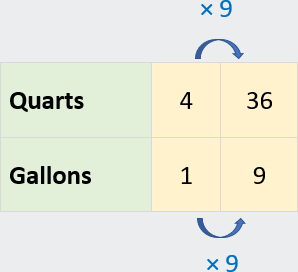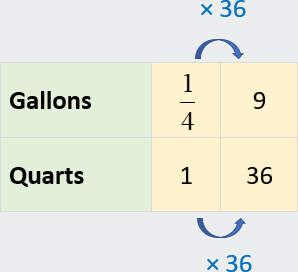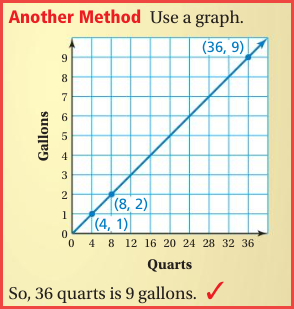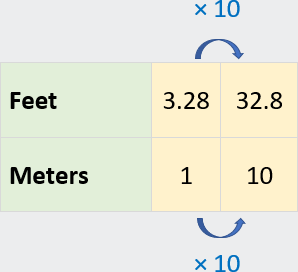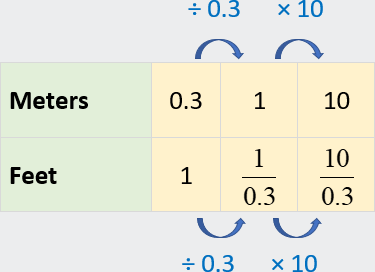Converting
Measures
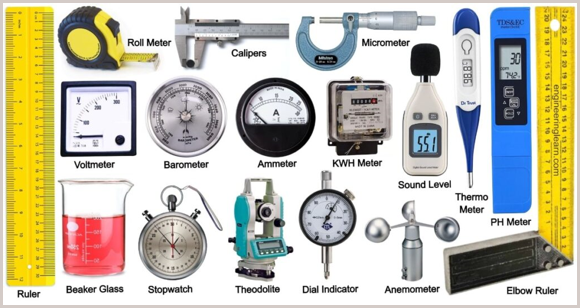
Unit Objective
●
Use ratio reasoning to convert units of measure
Key Vocabulary
●
Conversion factor - a number or formula used to convert a
measurement in one set of units to the same measurement in another set of units
●
Example: to convert feet to inches multiply by 12(
the conversion factor).
●
Unit analysis - using the rules of multiplying and reducing
fractions to solve problems involving different units
Example:
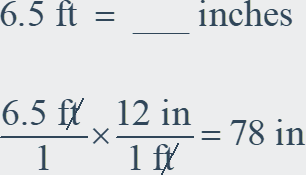
The following reference sheet can be used for many conversions.
Mathematics Reference Sheet
|
U.S. Customary 1 foot = 12 inches 1 yard = 3 feet 1 mile = 5280 feet 1 acre = 43,560 square feet 1 cup = 8 fluid ounces 1 pint = 2 cups 1 quart = 2 pints 1 gallon = 4 quarts 1 gallon = 231 cubic inches 1 ton = 2000 pounds 1 cubic foot ≈ 7.5 gallons |
U.S. Customary to Metric 1 inch = 2.54 centimeters 1 foot ≈ 0.3 meter 1 mile ≈ 1.61 kilometers 1 quart ≈ 0.95 liter 1 gallon ≈ 3.79 liters 1 cup ≈ 237 milliliters 1 pound ≈ 0.45 kilogram 1 ounce ≈ 28.3 grams 1 gallon ≈ 3785 cubic
centimeters |
Time 1 minute = 60 seconds 1 hour = 60 minutes 1 hour = 3600 seconds 1 year = 52 weeks
|
|
Metric 1 centimeter = 10 millimeters 1 meter = 100 centimeters 1 kilometer = 1000 meters 1 kiloliter = 1000 liters 1 milliliter = 1 cubic centimeter 1 liter = 1000 cubic centimeters 1 cubic millimeter = 0.001 milliliter 1 gram = 1000 milligrams 1 kilogram = 1000 grams |
Metric to U.S. Customary 1 centimeter ≈ 0.39 inch 1 meter ≈ 3.28 feet 1 kilometer ≈ 0.62 mile 1 liter ≈ 1.06 quarts 1 liter ≈ 0.26 gallon 1 kilogram ≈ 2.2 pounds 1 gram ≈ 0.035 ounce 1 cubic meter ≈ 264 gallons |
F = 9/5(C + 32)
|
Metric
The U.S. customary system is a system
of measurement that contains units for length, capacity, and weight. The metric system is a decimal system of measurement, based on
powers of 10, that contains units for length, capacity, and mass.
You can use unit rates and ratio tables to convert measures within the same
system and between systems.
Converting Measures withing the Same System
Example: Convert 36 quarts to
gallons.
Because 1 gallon = 4 quarts, there are 4 quarts per gallon and ľ gallon per
quart. You can use either of these unit ratios to find an equivalent rate with
36 quarts.
Method 1: Create a ratio table using the unit rate 4 quarts per gallon.
Multiply each quantity by 9 to find the number of gallons in 36 quarts.
|
Method 2: Create a ratio table using the unit rate ľ gallon per
quart. Multiply each quantity by 36 to find the number of gallons in 36 quarts.
|
|
Let's Practice.
1) Convert 48 feet to yards.
Converting Measures Between
Systems
Example: Convert 10 meters to feet.
Because 1 meter ≈ 3.28 feet, there are about 3.28 feet per meter. Because
1 foot ≈ 0.3 meter, there is about 0.3 meter per foot. You can use either
of these unit rates to find an equivalent rate with 10 meters.
Method 1: Create a ratio table using the unit rate 3.28 feet per
meter.
So, 10 meters is about 32.8 feet.
|
Method 2: Create a ratio table using the unit rate 0.3 meter per
foot.
|
Letís Practice.
1) Convert 7 miles to kilometers. Round to the nearest hundredth
is necessary.
 |
Conversion Factor
A conversion factor is a rate in
which the two quantities are equal. When using conversion factors, write rates
using fraction notation.
†††††††††††††††††††††††††††††††
| Relationship
|
Conversion Factors
|
|
| Example:
|
1 ft = 12 in
|
1 ft per 12 in, or
|
You can use unit analysis to decide which
conversion factor will product the appropriate units. You can ďcross outĒ a
unit that appears in both a numerator and denominator of a product.
In the following video, when it pauses you must answer the
question and click continue in order to play the rest.
Using Conversion Factors
Example: Convert 4 pounds to kilograms.
Use a conversion factor.
1 lb ≈ 0.45 kg

So, 4 pounds is about 1.8 kilograms
Example: Convert 5 yards per second to yards per minute.
Write 5 yards per second as a fraction. Then use a conversion factor.
1 min = 60 sec

So, 5 yards per second is 300 yards per minute.
Let's practice.
1) Convert 20 quarts to liters. Round to the nearest hundredth
if necessary.
 |
2)
Convert 60 kilometers per hour to miles per hour. Round to the nearest 100th if
necessary.
 |
Modeling in Real Life
| Example: A runnerís goal is to complete a mile in 4 minutes or
less. The runnerís speed is 20 feet per second. Does the runner meet the goal?
If not, how much faster (in feet per second) must the runner be to meet the
goal? To meet the goal, the runner must complete 1 mile in 4 minutes or less. The minimum speed required is 1 mile per 4 minutes. |
 |
To compare this speed to the runnerís speed of 20 feet per second, convert the
minimum speed of 1 mile per 4 minutes to feet per second.
So, the runner did not meet the goal because a speed of 20 feet
per second is below the minimum speed of 22 feet per second. The runner must be
22 Ė 20 = 2 feet per second faster to meet the goal.
Check: Verify the distances traveled in 4 minutes at the
runnerís speed and in 4 minutes at the additional speed have a sum of 1 mile.
| At runnerís speed
|
At additional speed
|
 |
 |
The sum of the distances is 4800 + 480 = 5280 feet, or 1 mile.
Let's practice.
1) A race car driverís goal it to complete a 1000-kilometer auto
race in 4 hours or less. The driverís average speed is 4200 meters per minute.
Does the driver meet the goal? If not, how much faster (in meters per minute)
must the driver be to meet the goal?
Metric Conversions
The following video presents an alternative and
quick way of doing metric conversions.
When the video stops, answer the question and click continue to continue viewing.
